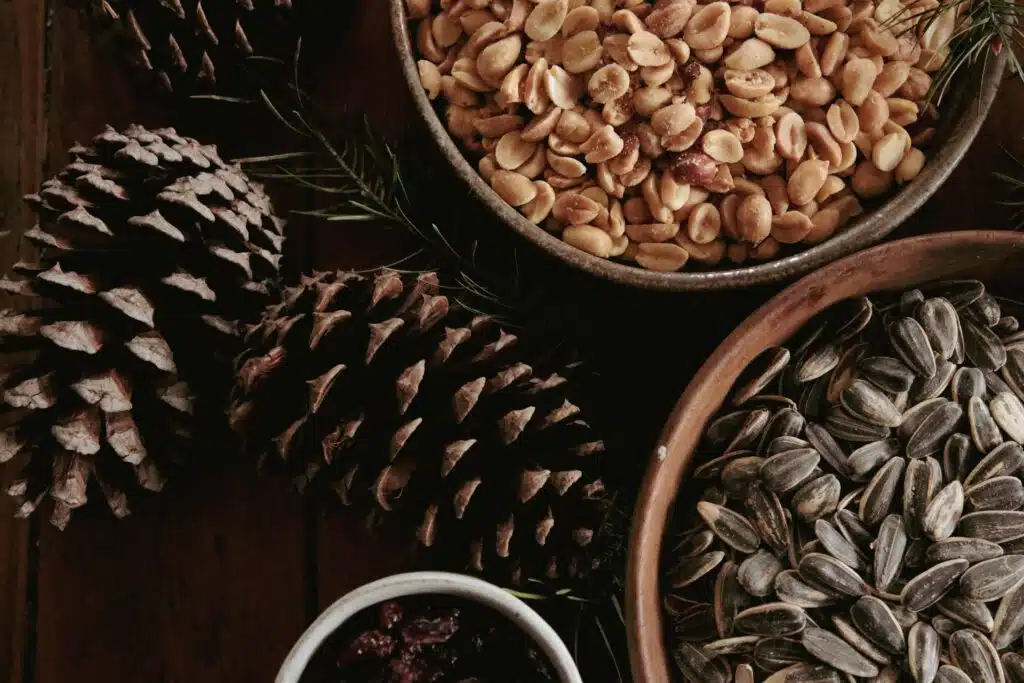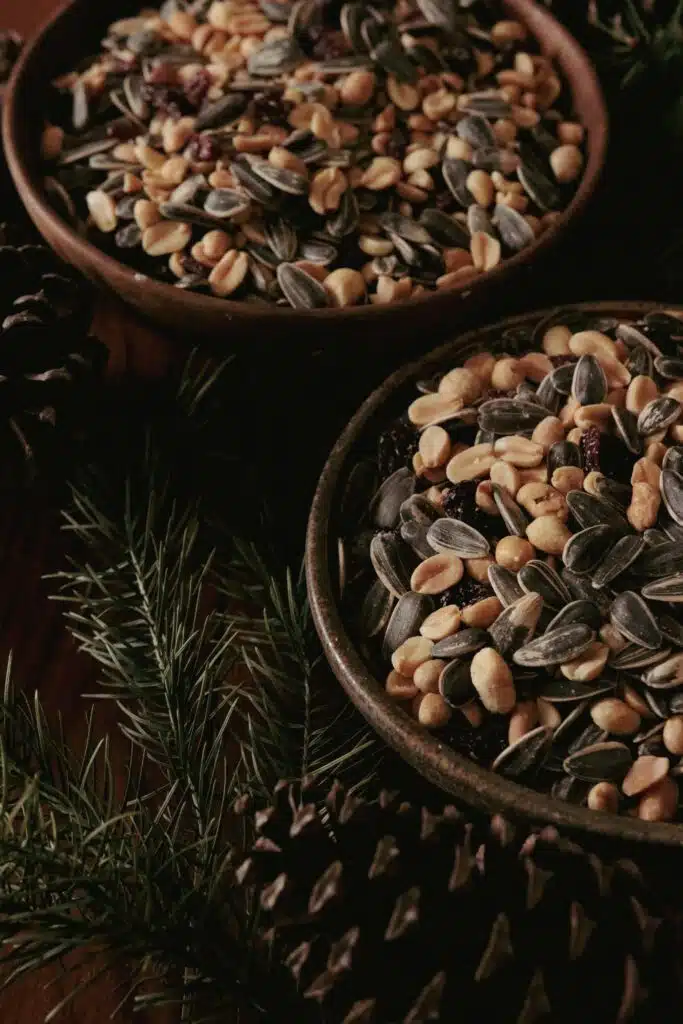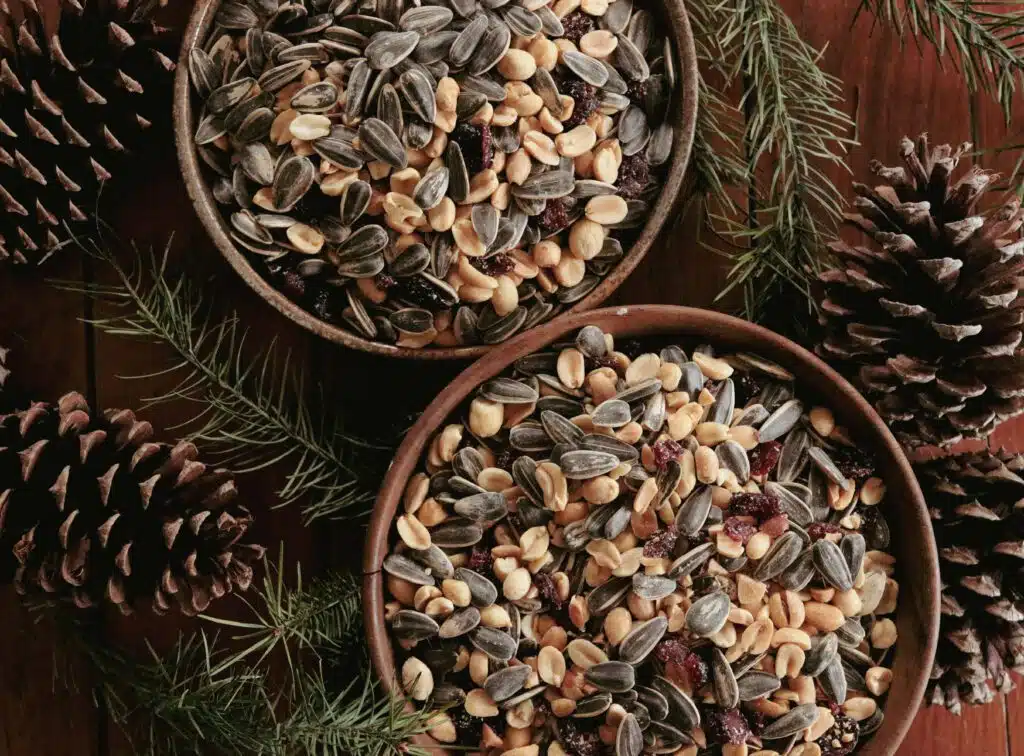
When I first moved into the cottage last year, I wanted to buy some really nice birdseed to attract a variety of local feathered friends. The winter is such a beautiful time to watch birds because they provide so much beauty and color in a season that is seemingly lifeless. After visiting my local birding store, I realized that buying organic, wild bird seed was going to be very expensive! My area is particularly known for its active feathered population, so I wasn’t giving up! After some research, I created my own birdseed and have been loving it ever since!
Why make your own birdseed?
There are more benefits to this homemade birdseed than saving money:
Better for the birds:
Usually, inexpensive bird seeds have lots of filler. For example, a grain called milo is not preferred by most backyard birds, according to the US Fish and Wildlife Services, but is prevalent in most store-bought blends. This filler takes lots of space in your feeder but is usually left behind by birds. After learning this, I realized that in order to get the most bang for my buck, I would need to make my own.
Better for your home:
I frequently like to make birdseed from scraps of peanuts, dried fruit, sunflower seeds, and anything else left over from recipes or snacks. Of course, make sure whatever scraps you use are safe for birds! This is a great way to use up or repurpose food to avoid waste.
How to make your own wild bird seed blend:

STEP ONE: Who do you want to attract?
Different species are attracted to different foods. Here are a few examples:
FRUIT
Orioles, Tanagers, Mockingbirds, Bluebirds, Thrashers, Cardinals, Woodpeckers, Jays, Starlings, Thrushes, Cedar, Waxwings, Yellow-breasted Chats
PEANUTS
Cardinals, Chickadees, Grackles, House Finches, Titmice, House Sparrows, Starlings, Mourning Doves, White-Throated Sparrows, Jays, Juncos
CORN
Starlings, House Sparrows, Grackles, Jays, Juncos, Bobwhite, Quail, Doves, Ring-Necked Pheasants, White-Throated Sparrows
MILLET
Doves, House Sparrows, Blackbirds, Juncos, Cowbirds, Towhees, White-Throated Sparrows, Tree Sparrows, White-Crowned Sparrows, Chipping Sparrows
SUNFLOWER SEEDS
Goldfinches, Chickadees, Woodpeckers, Nuthatches, Titmice, Redpolls, Pine Siskins, Cardinals, Jays, Crossbills, Purple Finches, White-Throated Sparrow, House Finches, White-Crowned Sparrows

STEP TWO: Pick a few ingredients from the following list.
I usually like to go with whatever is on sale in bulk at the store or online. All of these are safe and healthy for wild birds:
Don’t forget to choose raw, organic whole foods for your blend. Backyard birds do not want your leftover BBQ flavored peanuts! You can opt to roughly chop some of the seeds and nuts but you don’t have to.
STEP THREE: mix and serve
Mix your ingredients in a large bowl and spoon into your feeder. I have a few different ones I love, but this is my favorite style. I like to make a big batch every month or so and store the surplus in a jar for refills.
STEP FOUR: become a birder
Place your feeder somewhere you can easily watch for activity. I have a few strategically hanging on my front porch where I can watch from my living room windows. There is actually an incredible bird identification app that I use called Merlin. This app helps you identify and record which species you are seeing based on the date, location, and characteristics of the bird.
STEP FIVE: Enjoy
Casual bird watching is such a peaceful and slow activity to enjoy in winter. Taking time to provide food and identify different species gives me such a happy feeling during these long, cold days.

This post contains affiliate links, which means I make a small commission at no extra cost to you. You can view my Privacy Policy Here.
Should we be feeding wild birds at all? Is it disrupting the natural balance of their diet and environment, or is it a harmless way to connect with nature in our own backyards?
This is a great question! There are positives and negatives to feeding wild birds, but we have to remember that most wildlife near cities and suburbs are somewhat domesticated because we share their environment with them! Humans have changed the habitat of wild birds so much and taken away many of their natural sources of food and nesting that I think feeding them to help supplement can be helpful.
Hope this helps,
R
Some truly fantastic blog posts on this website , appreciate it for contribution.
What percentage of the blend do you use for each type of seed? Example–
40% sunflower, 10 % of peanuts, etc. I had a chart, now can’t find it. Thank you in advance.
Hey Marv, it’s really up to you! I often do equal parts sunflower seeds, dried cranberries, and peanuts. You can absolutely do any ratios you like…there are no rules!
xo,
Regina
Do you cut up the cranberries ( like in a blender)?
Thanks,
No, I use dried cranberries from the bulk section of the store.
Where do you get bulk supplies?
I get bulk supplies from a couple of places:
-ordered online from Azure Standard
-at my local bulk foods store
Incredible! This blog looks exactly like my old one! It’s on a entirely different topic but it has pretty much the same layout and design. Superb choice of colors!
Thank you so much! I spend a lot of time curating the photos, colors, and design so it’s really nice to hear positive feedback 🙂